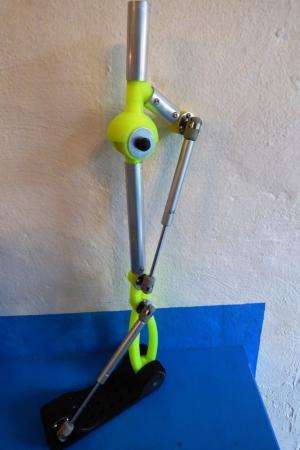May 22, 2014 weblog
Robohand shows work on prototype RoboLeg prosthetic

Robohand, a Pretoria, South Africa-based company providing reasonably priced prosthetics, has an early history described as "Just a South African Guy with an Idea." That guy is carpenter Richard van As who had a woodworking accident in 2011 where he lost all his fingers on his right hand. Ruder awakenings followed in looking for replacement digits and in discovering prosthetic prices. He set to work researching and developing a finger replacement for himself. Robohand evolved into a company that has made a difference for hundreds. Today, a person can be assessed for a Robofinger if missing a finger (the Robofinger was designed with the tradesperson in mind, needing something strong enough for physical work. The original Robofinger is CNC machined in aluminum) or, missing more or all fingers, a Robohand. A 3D printed Robohand has gained publicity as a lower-cost prosthetic assembled with medical grade Orthoplastic at a fraction of the cost of traditionally made prosthetics. Orthoplastic (thermoplastic) is moldable, breathable and washable.
Van As continued research and development, refining Robohand while focusing on safety, in pursuing reliance on high-grade materials but trying to keep the devices cost-effective. Robohands are not myoelectric and do not require invasive surgery. They do not have battery packs that add weight, require maintenance and increase cost. The PLA they are 3D printed with is biodegradable.
This month, news about this group took a step forward once more with a released picture on Facebook of RoboLeg, a 3D printable prosthetic leg that will offer hope for amputees to walk at a more affordable price as well. The leg uses pneumatic pumps. A 3D model of RoboLeg, while still awaiting testing, has been drawing enthusiastic comments on Facebook, where the announcement told visitors Robohand was proud to release the first prototype of the RoboLeg with "concept and functionality" in place. Van As said on the Facebook page that "It will be some time before we have a simple solution to measure and fit. The leg will also undergo a few pneumatic press tests before anyone should use it."
One can easily accept the care and time Robohand wants to devote toward the RoboLeg. Brittney Sevenson of 3DPrint.com noted that undertaking a leg prosthetic using 3D printed parts is not trivial. "A 3D printed leg prosthetic is much more difficult to create because the typical ABS or PLA plastic used with FDM based 3D printers generally lacks the strength to hold the weight of an average sized human being, over an extended period of time."
Also, one can sense from Robohand's website that Robohand has exercised considerable care that the products under its name maintain a reputation for quality and effectiveness for people who need such prosthetics. The home page states, "Robohand takes no responsibility for any hands created or distributed by individuals outside of Robohand. Only persons with certification from Robohand to create and fit hands/arms/fingers and working under the Robohand umbrella will be endorsed to ensure quality products and services."
More information: www.robohand.net/
© 2014 Tech Xplore

















